The Kaiser Wilhelm der Grosse was the first four stacked liner in the world to start operating across the Atlantic and quickly won the coveted Blue Riband, She was a symbol of luxury and opulence as well as an immigration ship operating between Germany and New York. If was her (and her three sisters) that spurned the Cunnard line to build Lusitania and Mauritania and thus White Star Line to build their three Olympic class liners.
However as War dawned in Europe the Kaiserliche-Marine had another purpose in mind for the great liner, one of a force of raiders patrolling the sea lanes to harass Allied shipping.
Much like her sister Kronprinz Wilhelm steps were taken to arm the liner but instead of rendezvousing with a cruiser at sea though the Kaiser Wilhelm der Grosse was already in Germany during the July crisis and so was taken into the Imperial ship yards for conversion. After a short time she was fitted with six 4.1” guns and two 1.5” guns.
On the 4th August,the Kaiser Wilhelm der Grosse undr the command of her Naval commander Korvettenkapitän Max Reymann and her former civilian master, Kapitan Meyer, sailed quickly through the North Sea from Bremen and up the coast of Norway before she headed towards the north-east of Iceland where, after a brief delay trapped in ice, powered south towards the Azores. On arrival Reymann began to add to his tally, having caught the 227 ton trawler Tubal Cain which was shelled some 50 miles West-North-West of Stalberg, Iceland on the 7th August.
Between 15–16 August, four vessels fell to the great liner.
The first vessel encountered, the Union Caste liner Galican had left Cape Town on 28th July and had had quite an uneventful journey up the west African coast and as far as Teneriffe. This is where news arrived of the War and that there was a danger from possible German raiders. Her Captain took steps to avoid capture altering his course to sit to the west of the usual shipping route, indeed the rumour of there being two German cruisers at Tenereffe he decided not to stop there, passengers were also advised to cover their port hiles every night as a black out but it was all for nothing. Ninety miles off Teneriffe smoke was seen on the horizon.
“A black, ugly-looking, four funneled steamer” flying the Imperial German Navy colours came alongside with orders to stop and cease all wireless communications - despite the Galican’s operator desperately sending a SOS at that very moment until the Germans aimed their guns at the vessel demanding that he stop immediately.
As would become a familiar incident over the next few months a boarding force of Germans came aboard with the officers demanding to see the ship’s papers. They did, however act in a very polite and professional manner, not in the brutish violent way that would become the propaganda depiction of the vile Hun. They were offered a gift of cigars and cigarettes from the Galican’s Captain but the offer was politely refused with the Germans believing that if they did so it could be twisted in the British Press as a robbery. The passengers were ordered on deck and inspected by the German officers whilst sailors dismantled the liner’s wireless set. Lieutenant J Deane of the East Lancashire Regiment first battalion and Gunner C Schurmer of the Royal Garrison artillery were taken out of the passengers and into custody of the boarding party and they informed the Galican’s Captain to proceed behind the Kaiser Wilhelm. With a final apology for any trouble given they departed for their ship with the passengers so impressed by their behaviour gave a cheer.The next day a signal from the Kaiser Wilhelm came to the following liner:
Keep reading with a 7-day free trial
Subscribe to Chris’s Naval History Substack to keep reading this post and get 7 days of free access to the full post archives.




